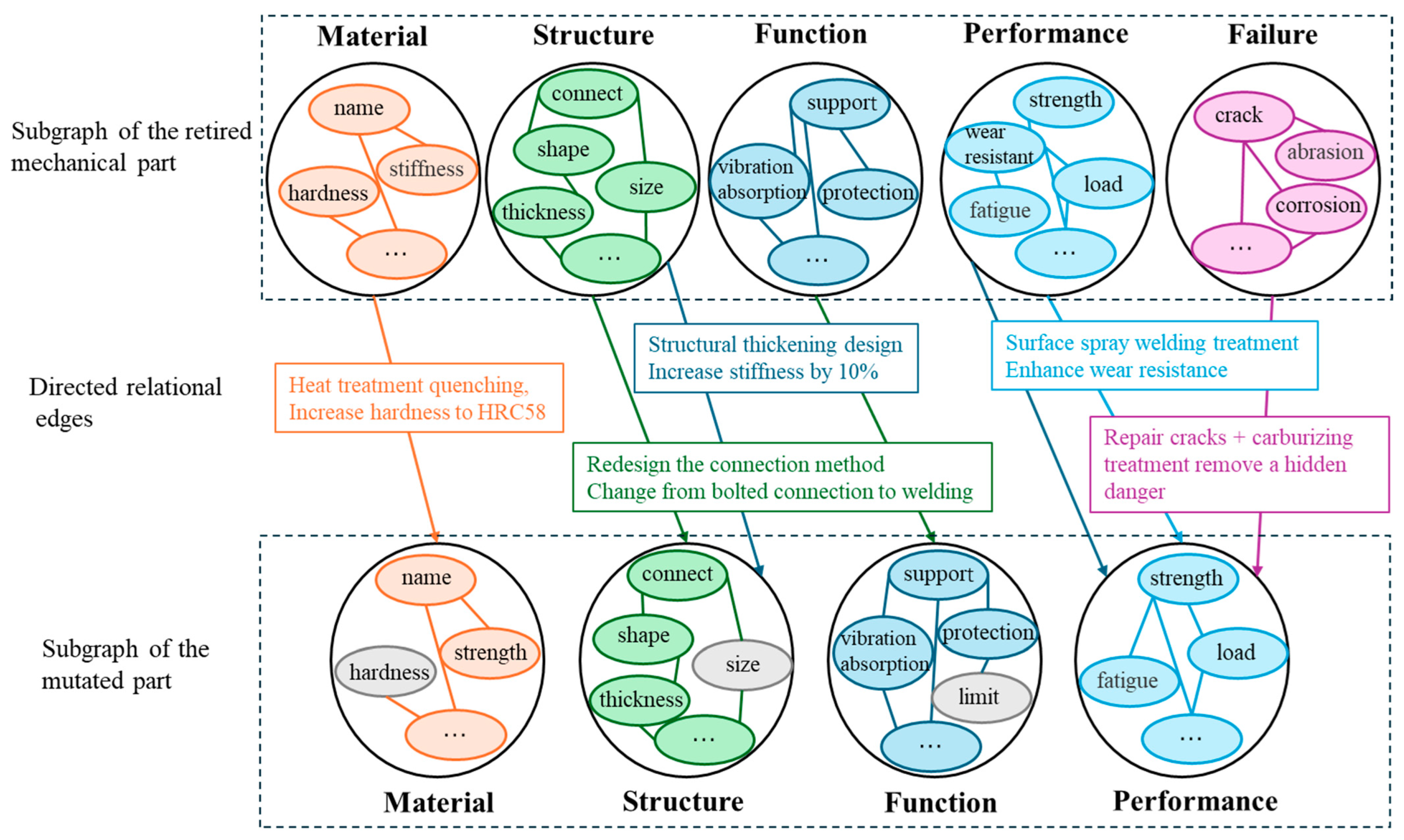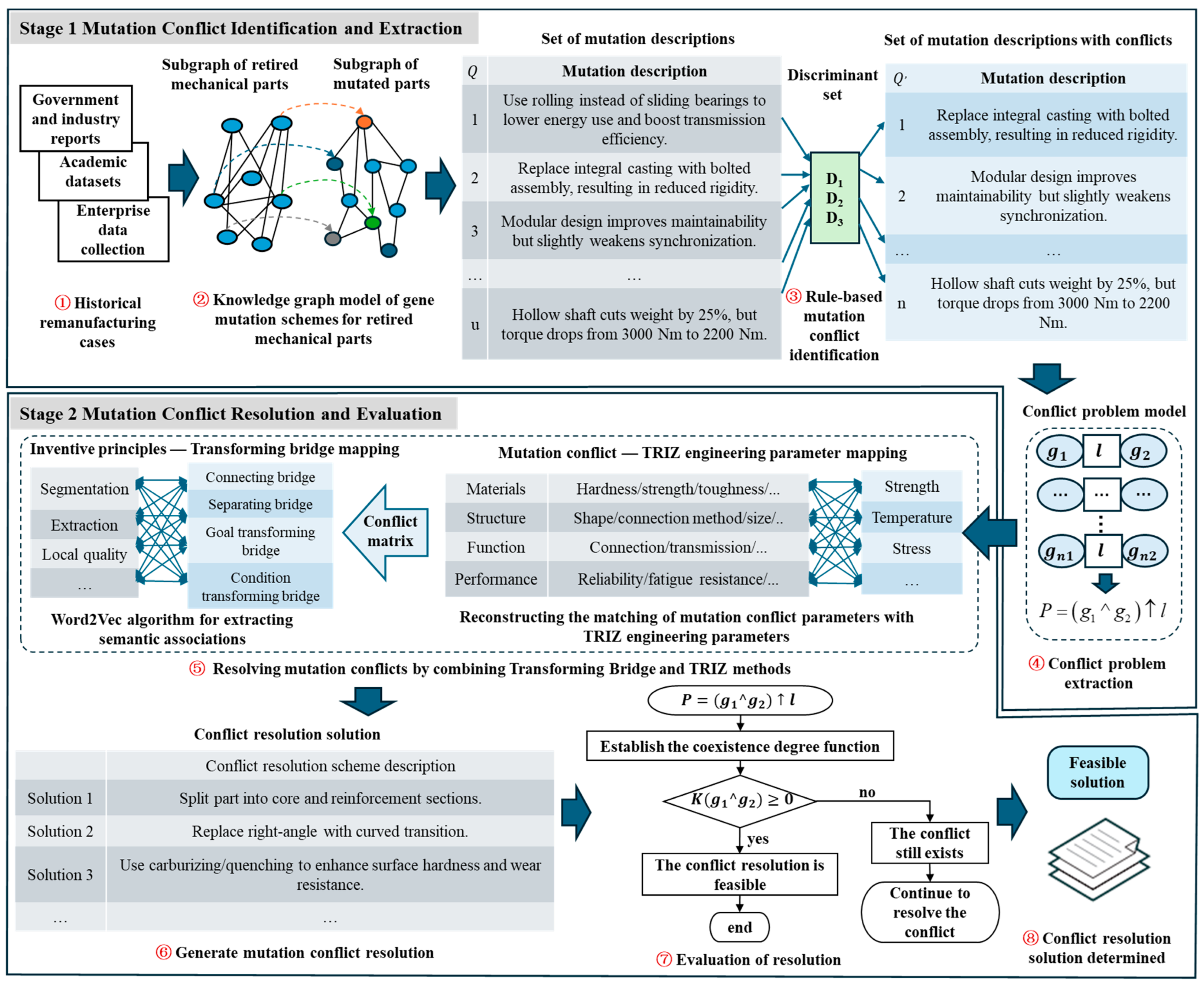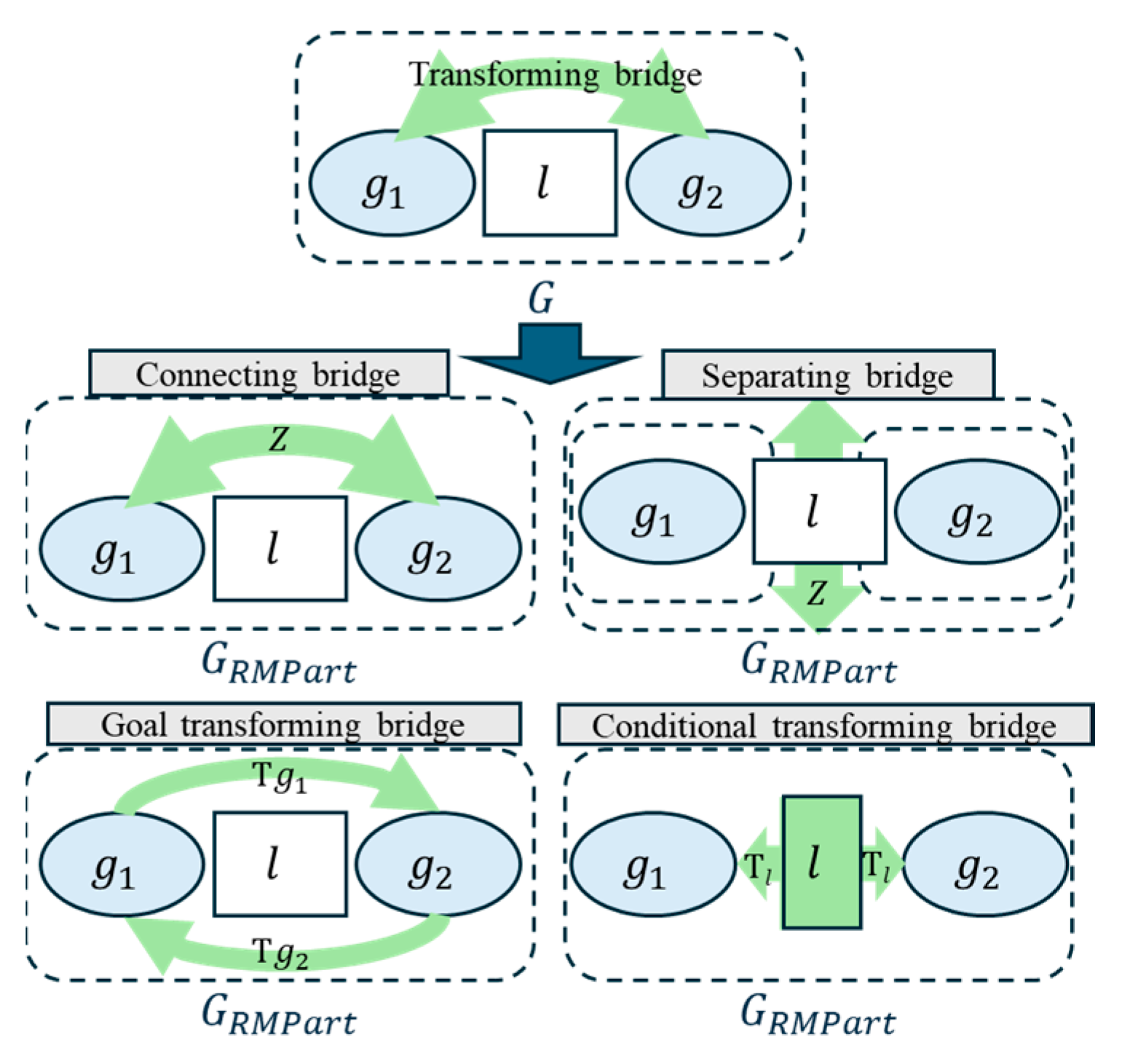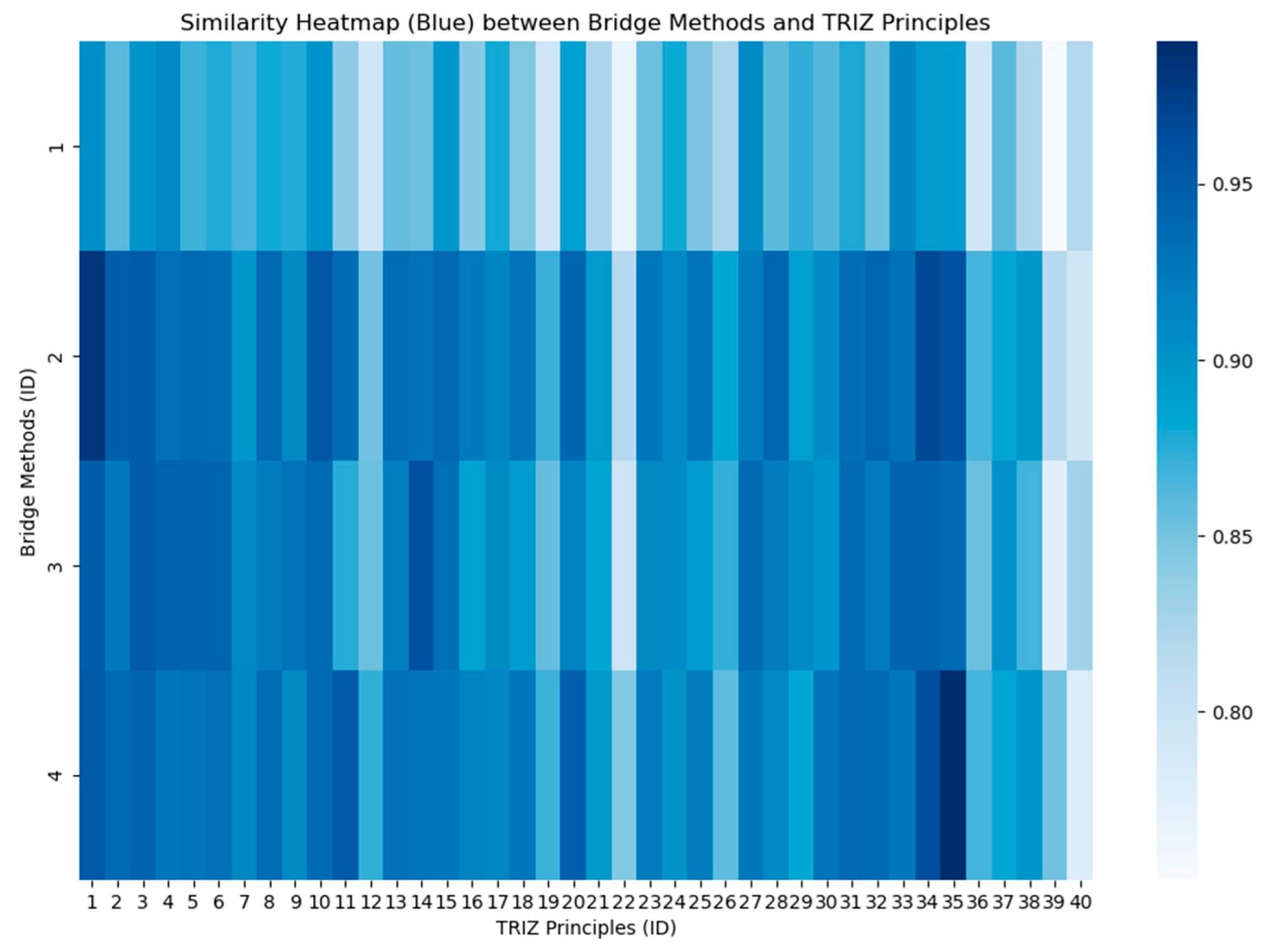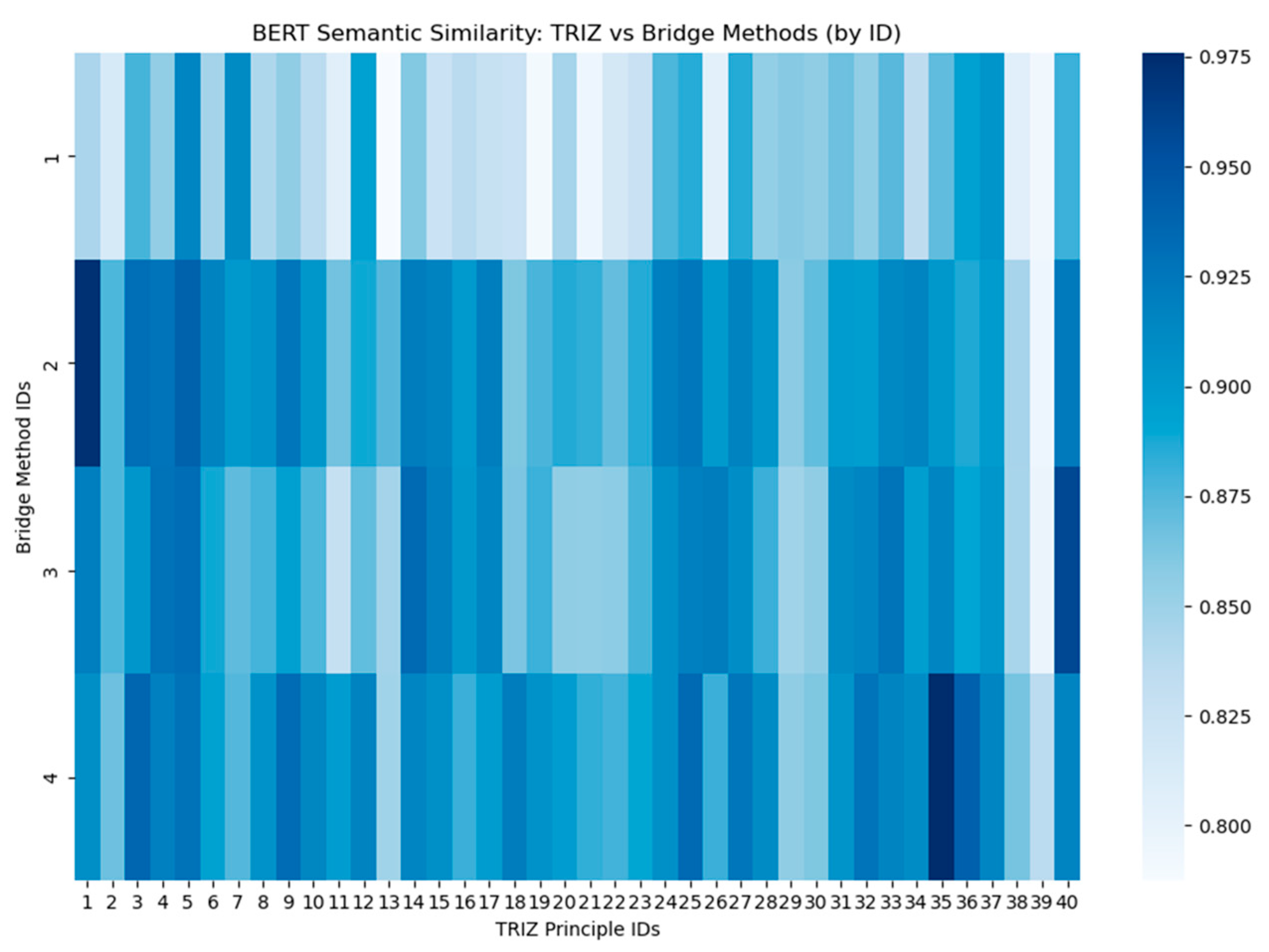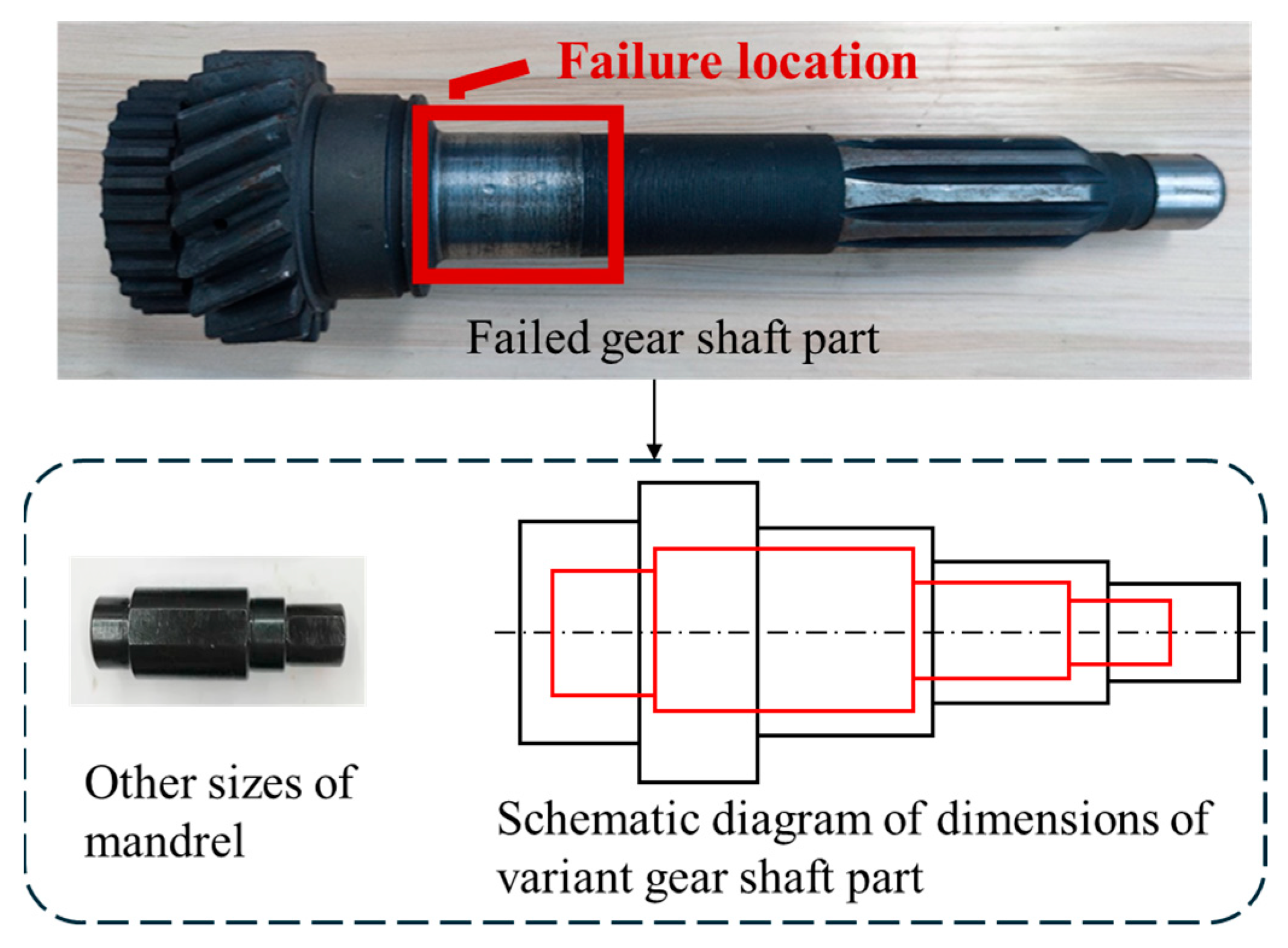1. Introduction
With the intensification of global industrialization and resource consumption, remanufacturing has become a key strategy for the green transformation of the global manufacturing industry, serving as an essential pathway toward circular economy and sustainable development. As fundamental components in industries such as aerospace, automotive, and engineering, mechanical parts contain substantial reusable resources and energy, including high-quality materials, complex structural designs, and mature manufacturing processes. If directly discarded, these resources not only result in significant material and energy waste but also impose considerable environmental burdens. Traditional remanufacturing mainly focuses on repair, aiming to restore retired products to their original or near-new condition, primarily addressing performance losses caused by part degradation. However, in practical industrial applications, retired mechanical parts often retain considerable residual value. Their reuse potential goes beyond simple restoration and extends to higher-level remanufacturing activities such as structural reconfiguration, functional migration, and performance enhancement. In response to this, our team has proposed the concept of generalized remanufacturing [
1,
2]. This approach emphasizes maximizing the regeneration of function, performance, lifespan, or value of retired products or components. It does so by means of restoration, upgrading, transformation, or functional reconstruction, while meeting multidimensional objectives related to resources, performance, and demand. Therefore, how to fully discover and harness the remanufacturing potential of retired mechanical parts and design the optimal generalized remanufacturing schemes has become one of the key approaches to enhancing the circular economy benefits of remanufacturing, promoting resource recycling, and fostering the sustainable evolution of industrial systems. However, the anisotropy and uncertainty of information such as material, structure, function, performance, and failure states of retired mechanical parts lead to great variability and flexibility in feasible remanufacturing schemes [
3]. To address this, we draw inspiration from genetic engineering and propose a model—referred to as the genes of retired mechanical products—that can comprehensively express both the basic state information of retired mechanical products and the dynamic evolutionary information throughout the generalized remanufacturing process [
4,
5,
6].
Biological genes are the fundamental units of genetic information in living organisms, determining their structure, functions, and characteristics. Similarly, retired mechanical part genes refer to a highly abstracted and encoded representation of key information related to a mechanical component’s structure, function, material, performance, and failure characteristics throughout its life cycle. These can be regarded as genetic units in an engineering context. In biology, gene mutation is a vital mechanism for individuals to adapt to the environment and generate new traits. In the field of engineering, part reconstruction in remanufacturing exhibits similar characteristics. Performance degradation, structural damage, or changes in application scenarios often trigger the need for property adjustments and optimization. The process of transforming a part from its original state through external interventions—such as repair, reconstruction, substitution, or parameter adjustment—toward functional reconstruction or upgrading displays significant mutation-like features. The gene mutation of retired mechanical parts refers to interpreting their state information as genetic data, which undergoes selective inheritance in response to varying customer demands. Through remanufacturing, these parts are guided to mutate and evolve in a favorable direction, enabling either restorative or transformative generalized regeneration. To accurately represent the gene mutation process of retired mechanical parts, each part is viewed as a composite information unit composed of five types of bases: material, structure, function, performance, and failure. By means of base information repair, replacement, and recombination, the part is driven to evolve from a failed state to a target state, thereby enabling the generation of diversified generalized remanufacturing schemes, extending the lifecycle of the part, and supporting the sustainable operation of industrial systems. This study adopts the abstract framework of biological genetic systems to construct a knowledge modeling and evolutionary reasoning paradigm oriented toward remanufacturing. It provides a structured and hierarchical modeling logic for representing part information and its evolution within complex engineering systems. Moreover, it offers a basis for multi-scheme comparison and evaluation in engineering practice, thereby enhancing the scientific rigor and operational stability of remanufacturing design.
However, gene mutation is not an isolated event. Its essence lies in the dynamic interplay of multi-attribute coupling within a complex system. Due to the high interconnectivity of the part genes, the modification of local bases of the part genes may disrupt the original system balance, triggering multi-dimensional conflicts such as material–performance and structure–function contradictions. For instance, the introduction of a high-hardness coating may reduce the toughness of the substrate, or lightweight design may conflict with load-bearing functionality. If such conflicts are not effectively identified and resolved, they will directly lead to the failure of the remanufacturing scheme or even cause cascading system malfunctions. Therefore, there is an urgent need for a conflict resolution method for gene mutation in retired mechanical parts, to support the design of optimal generalized remanufacturing schemes and to provide a theoretical foundation and engineering paradigm for resource circularity.
Current research on conflict issues mainly focuses on fields such as product design, TRIZ, multi-attribute decision-making, and evolutionary game theory. For example, Mao et al. proposed a conflict resolution method for real-time adaptive motion planning under task constraints in unpredictable dynamic environments, which enhanced the task execution capability and flexibility of robotic arms when encountering dynamically unknown obstacles [
7]; Wu et al. proposed a collaborative product design–innovation method based on axiom design (AD), theory of inventive problem solving (TRIZ), fuzzy logic, and grey relational analysis, which eliminates various complex conflicts that may arise during the early stages of conceptual design [
8]; Wang et al. proposed a new framework combining quality function deployment (QFD) with grey decision-making methods, used for collaborative quality design in large and complex product supply chains [
9]; Guo et al. proposed a method to support elastic concept design through functional decomposition and conflict resolution, by defining principles of elastic design and constructing a conceptual design process model to address conflict issues in complex systems [
10].
In the context of smart manufacturing, more scholars are focusing on research into intelligent conflict identification and analysis, as well as adaptive and autonomous decision-making mechanisms. Li et al. used current reality tree (CRT) to form a hierarchical representation of conflicts, employed conflict solution tendency network (CSTN) to search for conflict resolution trends, and applied ant colony optimization algorithms to analyze the optimal solution to conflict trends, addressing multi-conflict and efficiency issues in the product development process [
11]; Xu et al. proposed a conflict flow network iterative construction process model based on scalable conduction transformation, which resolved conflict issues in the product innovation–design process [
12]; Baby et al. considered collaborative design in product design and proposed an informative decision-making framework to model goal guidance, detect potential conflicts between multi-layer decisions, and enhance the performance of target products [
13]; Knigd et al. proposed a functional lifecycle energy analysis to address the synergy and conflicts between lightweight design and circular design in products [
14]; Mao et al. proposed a product concept design conflict resolution method that integrates deep learning and technological evolution models to solve conflict issues caused by product design constraints, helping designers generate innovative solutions [
15]; Huang et al. proposed an intelligent conflict resolution model based on multi-layer knowledge graphs to achieve the correlation and reasoning of multi-domain knowledge, improving the efficiency and reliability of conflict resolution during the conceptual design phase [
16].
The aforementioned literature on conflict identification and resolution during the new product design phase each presents unique innovations and applicable scenarios, offering significant inspiration for our research. However, studies specifically addressing conflict issues in the generalized remanufacturing of retired mechanical parts remain relatively scarce. In fact, compared with new product design, the gene mutations of retired mechanical parts are more complex due to uncertainties from their original service life—such as damage, aging, and performance degradation. To address this gap, we propose a conflict resolution method for gene mutation in retired mechanical parts. This method not only enhances the feasibility and adaptability of mutation schemes but also provides theoretical and data support for the realization of generalized remanufacturing of parts. The main contributions of this study are as follows:
- (1)
A mutation graph model for retired mechanical parts is proposed. This model systematically characterizes the evolutionary paths of key attributes—such as material, structure, performance, and function—during the remanufacturing process. It provides a basis for accurately identifying remanufacturing value and potential conflicts, thereby effectively supporting resource-efficient remanufacturing design;
- (2)
A method for effectively resolving mutation conflicts in retired mechanical parts is developed. This approach enables the decoupling of technical contradictions and the generation of resolution schemes. It aims to extend the service life of mechanical components and indirectly enhances the resource efficiency and ecological feasibility of remanufacturing solutions;
- (3)
The proposed method is validated through a case study. The results demonstrate that the method can generate innovative and technically sound conflict resolution strategies, extend the lifecycle of parts, and highlight the potential of remanufacturing design in achieving sustainable development goals.
The remainder of this paper is structured as follows:
Section 2 elaborates on the concept of gene mutation in retired mechanical parts and constructs its graph model to integrate gene information.
Section 3 proposes a conflict identification and extraction method based on discrimination rules and the element representation method in extenics. It also presents a TRIZ-enhanced transforming bridge method for generating conflict resolution schemes, with a coexistence degree function to evaluate their feasibility.
Section 4 presents a case study on the conflict resolution process in the gene mutation of a retired gear shaft, validating the effectiveness of the proposed theory and method.
Section 5 discusses the advantages and limitations of the proposed method.
Section 6 concludes the paper.
4. Case Study
The gear shaft is a critical component in gear transmission systems, responsible for supporting rotating parts and transmitting motion, torque, or bending moments. However, during operation, continuous contact with components such as sleeves, bearings, and bushings leads to relative surface motion, which causes friction and wear. Over time, this wear alters the shaft’s dimensions and compromises its original geometry, machining accuracy, and positional precision, ultimately reducing its operational efficiency and service life. We focus on a failed input shaft component from a gearbox, with its structural schematic illustrated in
Figure 8. The gear shaft is composed of 40Cr steel and features a cylindrical main body. The shaft end is composed of both a spur gear and a helical gear, which engage with external components for power transmission. Threads and splines are machined onto the main body to facilitate mechanical connections with external parts. The observed failure was attributed to thread deformation, which subsequently resulted in relative motion between the shaft and connected components, leading to wear.
We collected a corpus composed of text excerpts from publicly available Chinese online sources, including patents, academic papers, and datasets in the field of mechanical manufacturing and remanufacturing. A total of 145 text segments related to part remanufacturing were compiled and used as training data for the knowledge extraction model. Using knowledge extraction techniques, remanufacturing entities and their relationships were identified from the text and subsequently imported into a Neo4j graph database to construct the
mutation graph model, as illustrated in
Figure 9. The orange circles in
Figure 9 represent retired mechanical parts, the green circles represent parts under Generalized Remanufacturing, the blue circles represent base features, and the pink circles represent failure features.
The historical data were retrieved in order to establish the gene mutation description set Q for the gear shaft part, as presented in
Table 4.
Using the keyword extraction, rule-based classification rules, word segmentation, and other NLP toolkits in PyCharm 2023.3.2 (Community Edition), the mutation description set is evaluated through the discriminant set D, resulting in the discriminant outcomes shown in
Table 5.
In accordance with the aforementioned results, it can be concluded that method
entails the modification of the geometric dimensions of the shaft. However, due to constraints imposed by the original material and structural design, the newly manufactured component often fails to meet essential functional or performance requirements, such as enhanced load-bearing capacity or corrosion resistance under specific conditions. Consequently, the component is not immediately suitable for direct application. One representative variant scheme involves machining the gear section, worn journal, and spline area, followed by redesign and remanufacturing into a mandrel. In light of the shaft’s loading conditions and mechanical strength theory, the load-bearing capacity of a mandrel is generally determined by bending stress (
), as defined in Equation (10).
denotes the bending moment, determined by the applied load and the lever arm (i.e., ). Under the assumption of identical working conditions, the bending moment is considered constant.
represents the section modulus, which characterizes the shaft’s resistance to bending, , denotes the diameter of the shaft.
It can thus be concluded that the bending stress is inversely proportional to the cube of the shaft diameter. As the diameter,
d, decreases, the load-bearing capacity of the shaft rapidly declines. The original diameter of the gear shaft (root circle diameter) is insufficient to meet the design strength requirements of the new shaft. However, increasing the diameter is limited by the blank size and existing structural constraints. This creates a conflict between the redesign remanufacturing process and maintaining the shaft’s load-bearing capacity. Let
G1 = (structure, shaft diameter, d) represent the goal of modifying the shaft, and
G2 = (performance, load-bearing capacity, v) represent the goal of maintaining the shaft’s operational performance.
L = (L1, L2, L3) represents the conditions that must be met to achieve both goals
G1 and
G2, as detailed in
Table 6.
The goals, G1 and G2, are determined by the characteristics and values of the primitives in the conditions L. Therefore, the conflict can be expressed as (G1, G2) ↑ (L1, L2, L3).
By substituting
G1 = (structure, shaft diameter, d) and
G2 = (performance, load-bearing capacity, v) into the
mutant conflict parameters-TRIZ engineering parameter mapping table, the mapping relationship between the conflicting objectives and TRIZ engineering parameters is obtained, as shown in
Table 7. Among them, the engineering parameter to be improved is parameter 4, the length of the stationary object, and the engineering parameter to be protected from deterioration is parameter 11, stress. Upon querying the conflict matrix for engineering parameters 4 and 11, three inventive principles are identified: Principle 1, segmentation; Principle 14, curvature; and Principle 35, change of physical or chemical parameters. Descriptions of the corresponding inventive principles are provided in
Table 8.
By querying the mapping correlation similarity table between inventive principles and transforming bridge methods, the semantic similarity between the three inventive principles and the four transforming bridge methods can be obtained, as illustrated in
Table 9.
For each inventive principle, the transforming bridge method with the highest similarity is selected for implementation. The extenics transformations contained in the transforming bridge method are extracted, and the relevant elements are transformed to generate specific conflict resolution solutions.
Solution 1: Segmentation principle—separating bridge. The segmentation principle can be understood as decomposing the modified and remanufactured shaft structure into a core part (existing shaft) and an external reinforcement part. The construction method of the separating bridge involves interrupting the force transmission path of local shaft segments through structural reinforcement components (such as reinforcement sleeves), thereby enhancing the bending stiffness and overall load-bearing capacity of the shaft. It is assumed that the modified shaft part is used to manufacture a positioning mandrel, with a clearance fit positioning method and a four-step stepped shaft structure. The diameters of each shaft segment after size reduction are as follows:
Since Shaft Segment 3 of the mandrel is the assembly section and comes into direct contact with the mating component, its relatively long length and small diameter may lead to insufficient load-bearing capacity, making it prone to bending, instability, or fatigue failure. By adding a reinforcing sleeve to Shaft Segment 3, the diameter of the section is increased, thereby enhancing the moment of inertia . As a result, , meaning the bending stress on the segment is reduced, thus improving the shaft’s bending resistance.
Solution 2: Curvature principle—goal transforming bridge. The curvature principle emphasizes alleviating conflict problems through geometric transition forms. The construction method of the goal transforming bridge can be understood as a transformation of the target, , i.e., introducing a geometric transition into the mandrel structure. After modification, the diameter difference between Shaft Segment 1 and Shaft Segment 2 of the mandrel is 12 mm. Due to insufficient load-bearing capacity during use, fatigue fracture is likely to occur at the diameter transition between the two shaft segments. Based on the analysis of the curvature principle, a filet transition instead of a right-angle transition is applied at the diameter change of the shaft. By introducing a filet radius R, the stress concentration factor of the shaft can be reduced.
Solution 3: Change of physical or chemical parameters principle—conditional transforming bridge. Analyzing this principle, the primary approach to modifying the physical and chemical parameters of mechanical parts lies in treating the part material to alter its surface hardness or material properties. Specific techniques include surface carburizing or surface quenching, as well as applying high-strength or high-hardness coatings such as nickel-based alloy coatings or ceramic coatings, aiming to enhance surface hardness and wear resistance, thereby improving load-bearing capacity. Accordingly, a conditional transforming bridge can be constructed by transforming the material characteristics in condition . For the original 40Cr shaft part, its tensile strength is approximately 600–750 MPa, and its yield strength is about 350–500 MPa. After material treatment, these values can be increased to 810–980 MPa and 785–800 MPa, respectively, effectively improving the part’s dynamic load-bearing capacity and reducing crack initiation and propagation caused by cyclic loading.
After proposing a conflict resolution scheme for part mutation, the transforming bridge coexistence degree function should be used to determine whether the proposed scheme successfully resolves the conflict. Taking solution 1 as an example, in practical application, the reinforcement component is a shaft sleeve added to Shaft
Section 3, increasing its diameter from 30 mm to 40 mm. According to test data provided by the enterprise, the bending stress on the original mandrel part is 260 MPa, while after adding the reinforcement, the bending stress is reduced to 110 MPa. In engineering applications, the diameter range of mandrels is usually determined by specific application scenarios, load requirements, material properties, and manufacturing standards. Generally, for light machinery and general industrial equipment, the typical diameter range is [10, 80] mm. Thus, the qualitative mutation domain for the mandrel’s diameter characteristic can be defined as X = [10, 80] mm. For the retired shaft part selected in this section, the maximum diameter of the shaft section after being reduced to a blank is 60 mm, which determines the target quantitative mutation domain for the mandrel diameter as X
0 = [10, 60] mm. During the part mutation process, the more material is retained, the higher the value of the mutated part; therefore, X
0 = 60 is taken as the optimal point.
In engineering applications, the bending stress of a mandrel is typically determined based on the allowable stress of the material and specific working conditions. Generally, the bending stress range of a mandrel depends on the yield strength, fatigue strength, and safety factor of the material. For alloy steel, the allowable bending stress generally does not exceed 320 MPa. Therefore, the qualitative mutation domain for the mandrel’s load-bearing capacity characteristic can be defined as Y = [0, 320] MPa. After reinforcement, the bending stress of the mandrel part should be controlled within 260 MPa. Thus, the target quantitative mutation domain for the mandrel’s load-bearing capacity characteristic is Y
0 = [0, 260] MPa. Since the smaller the bending stress the mandrel bears, the better its stability, the optimal value is taken as y
0 = 0. Once all parameters are determined, they can be substituted into Equations (8) and (9) to obtain the following:
The calculation yields the coexistence function . In the transforming bridge coexistence function, if any target yields a negative value, it indicates a contradiction between the two related objectives. The absolute value represents the degree of opposition or conflict between the two objectives. Since the two conflicting objectives in the modified remanufacturing of the gear shaft do not yield a negative value under the current conditions, it indicates that there is no contradiction. Therefore, this scheme is capable of achieving effective conflict resolution.
5. Discussion
We propose a novel conflict resolution strategy for mutation. The proposed strategy integrates the fusion transforming bridge method and the TRIZ invention principle. The strategy constructs four types of bridges: a connecting bridge, a separating bridge, a goal transforming bridge, and a conditional transforming bridge. The strategy realizes a semantic mapping between the TRIZ invention principle and the transforming bridge method through the Word2Vec algorithm. Additionally, a coexistence degree function is introduced to quantitatively evaluate the effectiveness of conflict resolution, thereby enabling systematic identification and intelligent resolution of technical conflicts during the mutation process.
From a methodological perspective, the strategy boasts several advantages. First, it integrates the TRIZ theory and the transformation bridge method, providing multiple solution paths for conflict resolution from multiple dimensions. This enhances the breadth and innovativeness of the solutions. Second, it realizes an intelligent matching between TRIZ invention principles and the transformation bridge strategy through the semantic mapping mechanism, improving the relevance and effectiveness of the solution recommendation. Third, it introduces the coexistence function to quantitatively evaluate solution effects, helping to optimize the screening and decision support among multiple conflict resolution paths.
From a theoretical perspective, the conflict resolution mechanism is extended to the modeling and mutation analysis of mechanical part genes. And a generalized model for conflict transformation and solution generation is established. It provides systematic methodological support for conflict identification, transformation, and innovation in the remanufacturing process, enriching the cross-disciplinary integration and application pathways of TRIZ theory and extenics in the engineering domain.
From an application perspective, this strategy holds significant value in enhancing the systematic, intelligent, and sustainable development of remanufacturing processes for retired mechanical parts. By identifying and resolving gene-level conflicts, it effectively supports functional reconstruction and performance improvement during repair, optimization, and redesign. Moreover, it provides methodological support for intelligent decision-making in remanufacturing service systems, thereby improving resource utilization efficiency.
However, the proposed method in this study still faces certain limitations in practical applications.
- (1)
Due to limitations in experimental equipment and data collection conditions, the data used in this study are all from Chinese corpora, and the semantic processing techniques applied have been specifically adapted to the characteristics of the Chinese language. If the proposed method is to be extended to an international context, targeted modifications will be required. In addition, the robustness of the proposed knowledge graph model has not yet been validated in large-scale or more complex scenarios involving sparse or low-quality data. However, the graph modeling method developed in this study, based on semantic relation extraction and node structure optimization, provides a certain degree of scalability and adaptability. Future studies may further explore and address this issue by optimizing the technical framework and data acquisition mechanisms, thereby enhancing the model’s applicability in more complex environments.
- (2)
This research primarily focuses on the technical feasibility of the remanufacturing process. The current coexistence degree function does not fully incorporate the multidimensional impacts of technical, economic, and environmental factors. Nevertheless, the proposed method lays a solid theoretical and modeling foundation for future studies on trade-offs between performance and cost. It could be further extended by integrating economic and environmental evaluation indicators, enabling multi-objective conflict assessment and optimization in terms of performance-cost or resource efficiency. This would offer a more comprehensive reflection of the synergy between economic and sustainability goals in remanufacturing.
- (3)
The applicability and feasibility of the method in complex engineering environments require further enhancement. The gear shaft used in the case study represents a typical rotating mechanical component, exhibiting representative failure modes (e.g., fatigue fracture and surface degradation) and performance evolution characteristics, thus partially demonstrating the practical value of the proposed method. However, the method still shows limitations in addressing integrated conflicts in complex systems involving multi-level, multi-scale, and multi-objective coupling. Even so, this research provides an exploratory approach that bridges theory and practice for remanufacturing conflicts of complex components, with potential for further refinement and cross-industry application. Future work may expand the gene modeling framework to the “product” level and explore optimization methods for coordinated multi-conflict resolution, thereby meeting the demands of complex systems.
In summary, the conflict resolution strategy proposed in this paper exhibits significant innovation and applicability in both theoretical research and engineering practice. However, further research is necessary to enhance model intelligence, semantic precision, and multi-objective trade-offs. This will provide more comprehensive support for intelligent decision-making of remanufacturing under complex systems in the future.

